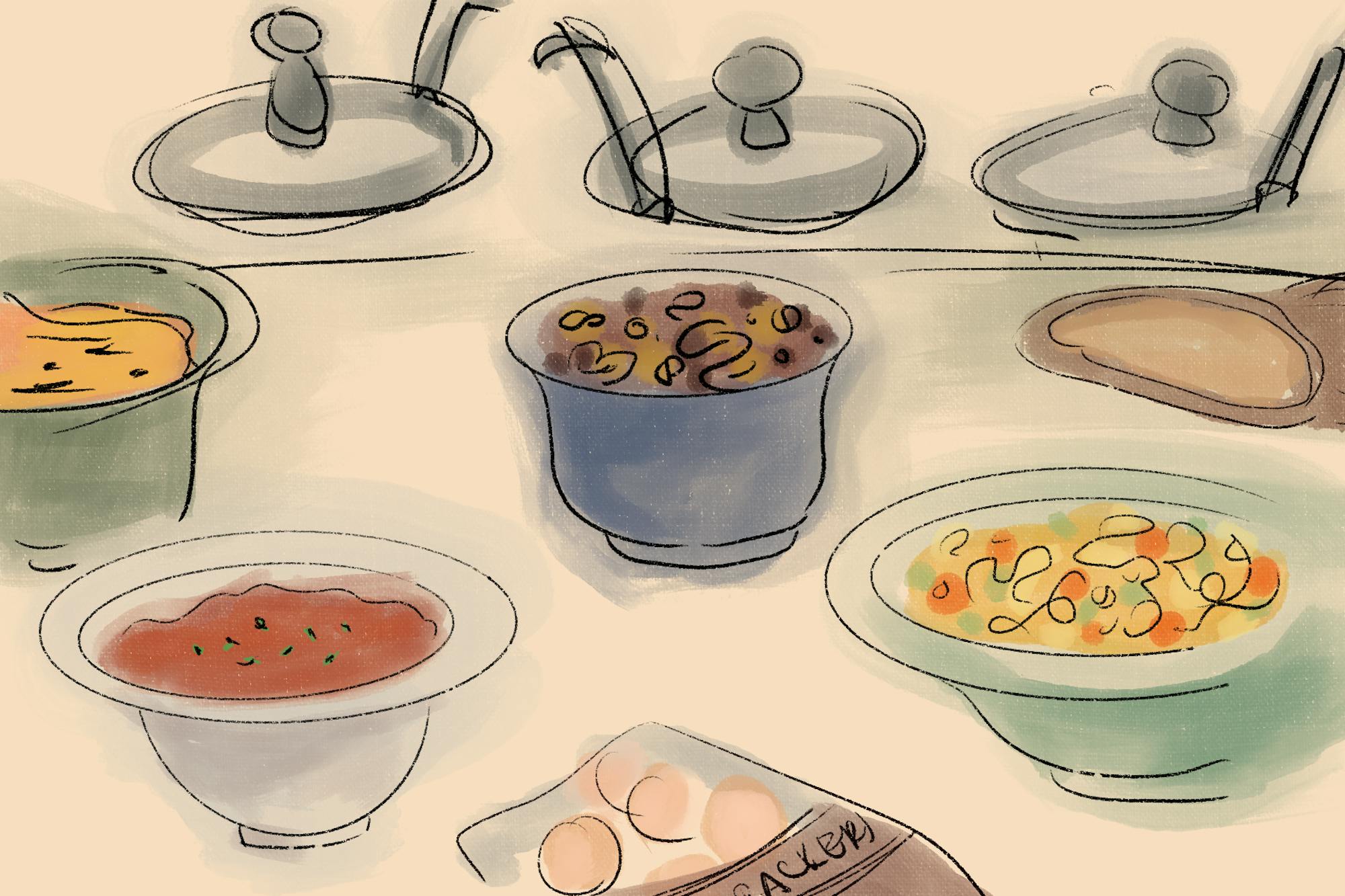As a first-year student on the Ivy Unlimited meal plan — which offers unlimited swipes into the Class of 1953 Commons, known colloquially as Foco — I eat many-a-bite at the College’s main dining hall. In all my meals there, I’ve realized that I gravitate toward one food station much more often than the others — the soup station.
Truth be told, my love for soup began long before I arrived at Dartmouth last fall. I grew up two hours from San Francisco and have fond childhood memories of clam chowder in large sourdough bread bowls from Boudin Bakery SF, a sourdough-specializing eatery in the Bay Area. Even at home, I can recall the warmth provided by my mother’s steaming hot soups.
When I arrived on campus, I did not have particularly high hopes for any of the College’s dining options. But two and a half terms later, I will admit that I have been pleasantly surprised — particularly by the soups.
But what is it about these Foco soups that I love so dearly?
Maybe it’s the fact that they have soothed me as I have recovered from multiple illnesses, or that they consistently warmed me up during my first Hanover winter. Or perhaps soup, as a concept, just reminds me of home and healing. In fact, Foco’s soups are so rejuvenating and home-like that I’ve always believed they were made from scratch. It turns out that assumption missed the mark.
The majority of Foco soups are, in fact, store bought, according to Dartmouth Dining’s registered dietician and nutritionist Beth Rosenberger.
“I might be breaking your heart or disappointing you,” Rosenberger said, explaining that Foco workers simply do not have the time nor resources to make all of their soups from scratch. She said the dining hall only has two big “steam-jacketed kettles” in house, which uniformly heat the contents from all sides and are essential to the soup-making process.
Although Rosenberger said she and other Foco staff members “would love to be able to make homemade soups every day or frequently,” they instead purchase soup pouches from Kettle Cuisine, a Massachusetts-based company.
“We serve nearly every soup they make [for their food service line] because they’re all so good, and they do seem like they’re [made from] scratch,” Rosenberger said. “We are proud of their soups, and we think they fit the bill here.”
I will admit, I felt a bit betrayed by this information. In my time at Dartmouth, I have built up quite the reputation among my friends as a passionate Foco soup enthusiast. A soup-er hero, if you will. And while this news does not make the College’s offerings any less heavenly, my lack of knowledge makes me feel less deserving of my title.
However, there are still some varieties that Foco’s soupsmiths craft by hand. According to Dartmouth Dining’s executive chef Christopher Kaschak, soups from A9 — the Foco kitchen that is free from the top nine allergens — and Pavilion, Foco’s kosher station, are made from scratch. In addition, soups at the Herbivore station or ones made for special events, such as theme nights, may also be homemade, Rosenberger explained.
Whether these soups are handcrafted or store-bought, I, of course, have my favorites:
- Chicken & Dumpling: It’s like eating a warm hug. An addictingly perfect winter soup. Honestly, it’s perfect for any season. Bonus points to Foco for introducing me to it.
- Chicken Noodle: It’s hard to do a classic well, but Foco goes above and beyond with the ultimate sick day soup. Even when it’s slightly cold from being left out for a while, I still want to devour it — that’s how you know it’s good.
- New England Clam Chowder: Nostalgic, of course. The clams in here are truly exquisite. It has a wonderful consistency, too — full of goodness, and it tastes like the sea.
After Kaschak told me which soups were most popular among the student body, I realized just how classic my top picks are. That said, I can’t say the top choice was a huge surprise.
“Chicken noodle, number one, is absolutely the most popular,” Kaschak said.
Other well-liked soups include the New England clam chowder, the Manhattan clam chowder, the black bean and the corn chowder, he added.
Tomato basil soup is particularly sought after, especially when it’s paired with another menu item: the grilled cheese. According to Kaschak, grilled cheese consumption at Foco doubles when tomato basil is also on the menu.
Rosenberger added that Foco even gets requests through Dartmouth Dining’s text-n-tell service, a message interface that allows students to express opinions about food offerings, to coordinate for the two to appear on the menu together.
“When it was still colder we got multiple [text-n-tell] requests [saying,] ‘Can’t you please make sure that there’s grilled cheese at the grill … every day that there’s tomato soup on the menu?’’’ Rosenberger said.
Although tomato soup and grilled cheese lovers may want the combination available every day, we all know that too much of a good thing never ends well. That’s why Foco’s three-week soup rotation schedule comes in handy, ensuring that everyone’s favorite combinations appear a handful of times per term.
Kaschak, who is in charge of creating the Foco menu grids — which determine when certain food items will appear on the menu — showed me his impressive three-week-long plan of soup offerings: seven days a week, four soups a day.
While developing the grid, Kaschak said he remains mindful of certain considerations, such as selecting a “vegan, vegetarian and gluten-free offering” every day. He also likes to include “a clear soup, a chowder daily and then just a mix [of] whatever [soups] I can.”
Although Foco does follow its schedule rather closely, the grid is still subject to change, Kaschak explained.
“If we have … extra [soup] left from the day before, we want to run that out so we’re not discarding it,” he said.
Still, Foco does not limit its menu to the soups that are currently in rotation. They also take outside recipes, according to Rosenberger.
“We’d love to get recipes from home,” she said. “[Or] we’d love for people to ask us to create things that they miss from home.”
But before the recipe hits the pots in Foco, each variety must first go through a testing process. If the recipes “work out, they appear on next term’s menu,” according to Rosenberger.
“We usually get [the recipes] in our system and test them during … break times because it’s a little bit slower,” she said.
So if Foco soups don’t leave you satisfied, you have the power to change the offerings. But I’ll be here, messily scooping ladles of New England clam chowder into a teal-colored bowl — for the second time that day.




